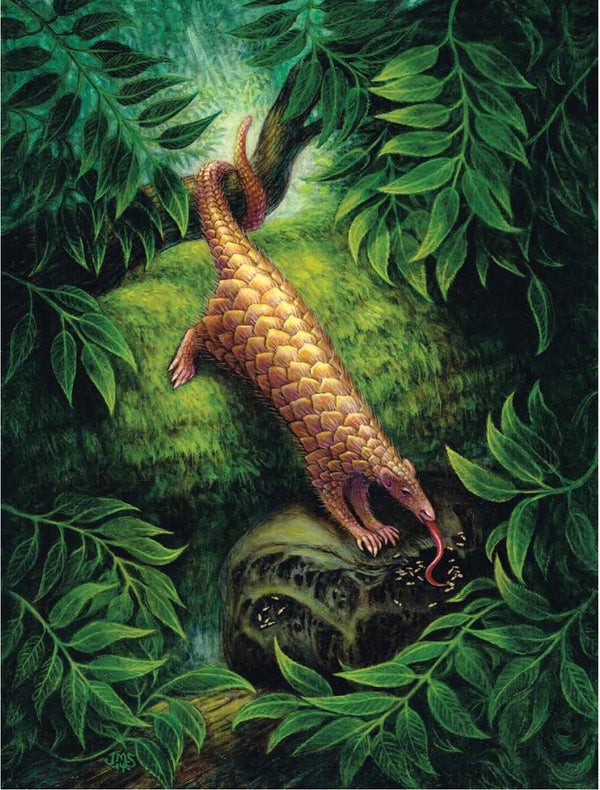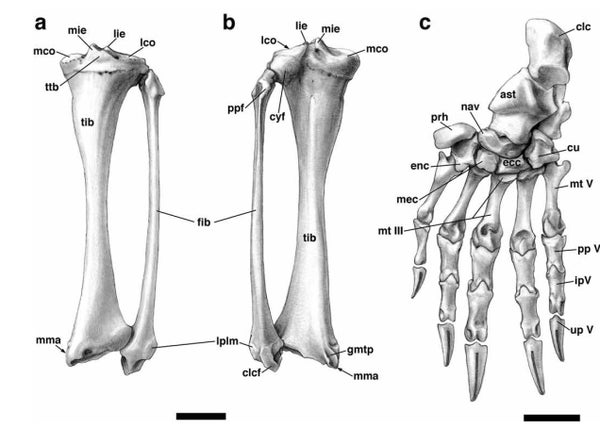This article was published in Scientific American’s former blog network and reflects the views of the author, not necessarily those of Scientific American
I've often said that one of the reasons we seem to adore dinosaurs more than fossil mammals is because the terrible lizards seem so strange. This isn't objective. It's really a matter of time. Apatosaurus is an oddity because there's no modern equivalent, and, while impressive, we'd probably consider the dinosaur to be no more exotic than a zebra if it had a living relative to look at. If we can throw out this temporal constraint on our adoration, though, we can see that there are fossil mammals that are just as charming and bizarre as any dinosaur, among them America's one and only pangolin.
There are eight pangolin species alive today scattered through Africa and Asia. Fossil examples have been found in Europe, as well. But so far, Patriomanis is the only pangolin ever found in the Western Hemisphere. It first came to the attention of paleontologists over 40 years ago when a partial skeleton was found in Wyoming, nestled in rocks over 34 million years old that represented a time when the Cowboy State was clothed in thick semitropical forest. And as paleontologist Timothy Gaudin and coauthors write in a new report on Patriomanis, additional skeletons have now filled in some anatomical gaps to allow researchers a more detailed look at this ancient pangolin and how it made its living.
Despite being so old, Patriomanis probably behaved much like its living relatives. The hands, limbs, and tail of this Eocene beast resemble those of its modern, sharp-clawed and long-tongued counterparts, hinting that Patriomanis also feasted on social insect nests and had a prehensile tail. The hands claws of Patriomanis were not as impressively large as in modern pangolins, along with other differences, but the constellation of anatomical traits indicate that Wyoming's pangolin likely clambered through the trees, anchoring itself with its tail, to claw open the strongholds of termites and the like.
Pangolins have been carrying out their peculiar lifestyle for longer than our brains can properly comprehend. But how much longer these "perambulating pinecones" will continue to trundle across the land in search of termite nests to slurp up is up to us - these are critically endangered mammals, just recently given more extensive international protection to curb the poaching and trafficking that's driving them towards extinction. To lose them would be a true shame. Not only are pangolins charming weirdos with bodies covered in scale-like armor and tongues that boggle the mind, but Patriomanis and other fossils testify to the fact that they are a great evolutionary success story. If that tale comes to an abrupt and tragic end, we have only ourselves to blame.
For more on how you can help pangolins, check out SavePangolins.org and Pangolin Conservation.

Patriomanis americana in the Eocene of Wyoming. Credit: Julia Morgan Scott, Guadin et al. 2016
Fossil Facts
On supporting science journalism
If you're enjoying this article, consider supporting our award-winning journalism by subscribing. By purchasing a subscription you are helping to ensure the future of impactful stories about the discoveries and ideas shaping our world today.
Name: Patriomanis americana
Meaning: "America's father claw", in reference to the pangolin's early age and where it was found.
Age: Eocene, over 34 million years old.
Where in the world?: Wyoming, USA.
What sort of critter?: A pangolin, an insect-eating mammal with (very endangered) relatives still alive today.
Size: Comparable to today's pangolin species.
How much of the creature’s body is known?: Six specimens, five of which are partial skeletons that together represent almost every bone in the body.
Reference:
Gaudin, T., Emry, R., Morris, J. 2016. Skeletal anatomy of the North American pangolin Patriomanis americana (Mammalia, Pholidota) from the Latest Eocene of Wyoming (USA). Smithsonian Contributions to Paleobiology. doi: 10.5479/si.1943-6688.98
Previous Paleo Profiles:
The Light-Footed Lizard The Maoming Cat Knight’s Egyptian Bat The La Luna Snake The Rio do Rasto Tooth Bob Weir's Otter Egypt's Canine Beast The Vastan Mine Tapir Pangu's Wing The Dawn Megamouth The Genga Lizard The Micro Lion The Mystery Titanosaur The Echo Hunter The Lo Hueco Titan The Three-Branched Cicada The Monster of Minden The Pig-Footed Bandicoot Hayden's Rattlesnake Demon The Evasive Ostrich Seer The Paradoxical Mega Shark The Tiny Beardogs The Armored Fish King
